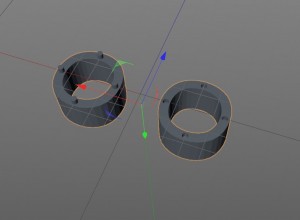Part of the design challenge for the models for the Taping Shape* exhibit, was to find a way to join them together. I was inspired by Jason Cantarella’s Decomposition of a Cube Manipulative which uses small magnets to join the pieces together. These magnets are 3mm (diameter) x 3mm (height) cylindrical rare earth magnets.
To make holes for the magnets I made a cylinder of height 6.4mm and radius 1.6mm. I knew I needed to use the Boole tool to create the holes. Most importantly, I had to make sure to that the holes perfectly aligned on different pieces. Cinema 4D has a wonderful Array tool, which I used to create an array of four cylinders centered at the origin. I adjusted the radius of the array until the cylinders were perfectly placed on the pair-of-pants model. The 6.4mm height of the cylinders allowed me to position the models above or below the array, so the height of each hole was precisely 3.2mm.
I then moved the different models (or the array) around the origin to get four holes perfectly placed in each rim of the pair-of-pants, ring and caps models. The photo below shows the ring system for the pair-of-pants with the cylinder array ready for the Boole tool on the left. The ring on the right is ready to go. After printing, I found that the magnets fit snugly and would not come out. If you are worried about this, Jason used a little JB Weld epoxy. (He suspects that you could also use superglue.)
After printing, I found that the magnets fit snugly and would not come out. If you are worried about this, Jason used a little JB Weld epoxy. (He suspects that you could also use superglue.)
Putting the magnets in was nearly impossible. However Jason’s magnet insertion tools were just awesome. They allowed me to seat the magnets into the little holes, and helped me keep track of which end of the magnet went where. I strongly recommend printing the \(+\) and \(–\) magnet insertion tools in different colors to help with this. I put down one tool to check a print, then picked the other one up instead, messing up the placement of the magnets. (I discovered the hard way that the magnets really don’t come out…)
For the pair-of-pants and caps models, I alternated the \(+\) and \(–\) ends of magnets around the rims of the pair-of-pants. I did this in a consistent way, for example the \(+\) was always at the front and back of the pants. For the rings, the plain ones should be aligned the same alternating way on the top and bottom rims. The ones with plus/minus signs or 90 degrees should have the arrangement rotated by 90 degrees.
The end result? Models which snap together in a satisfying way. The reason for the rings should now be clear. Without them, the models connect in only two possible orientations. With them, the models can be snapped together in four different ways.
*The Taping shape exhibit is part of the InforMath project funded by the National Science Foundation (DRL-1323587). (The InforMath Project is a partnership between San Diego State University and several museums at the Balboa Park, including the Rueben H. Fleet Science Center .)
